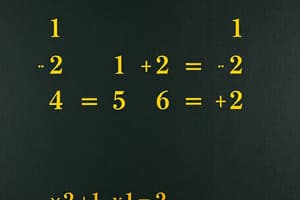Podcast
Questions and Answers
A number line is a visual representation of numbers arranged along a continuous horizontal, vertical, or circular ______.
A number line is a visual representation of numbers arranged along a continuous horizontal, vertical, or circular ______.
axis
A number line helps students understand the order of magnitude and how numbers relate to each ______.
A number line helps students understand the order of magnitude and how numbers relate to each ______.
other
A number line can be compared to a ruler, where one end represents ______.
A number line can be compared to a ruler, where one end represents ______.
zero
By seeing the relationship between numbers, learners can better understand the distances between numbers and the differences in quantities represented by those ______.
By seeing the relationship between numbers, learners can better understand the distances between numbers and the differences in quantities represented by those ______.
A number line helps students associate number value with its position on the line, making it easier to compare and calculate changes in quantity or ______.
A number line helps students associate number value with its position on the line, making it easier to compare and calculate changes in quantity or ______.
Using a number line has several advantages when teaching or learning mathematical concepts, including ______.
Using a number line has several advantages when teaching or learning mathematical concepts, including ______.
Flashcards are hidden until you start studying
Study Notes
Number Order
Number order is a system used to arrange numbers in a specific sequence. Understanding this concept is crucial as it enables us to make sense of numerical data presented either verbally or visually. This understanding also allows individuals to complete mathematical operations effectively. In this article, we will discuss the different aspects of number order, with a focus on the number line.
Number Line
A number line is a visual representation of numbers arranged along a continuous horizontal, vertical, or circular axis. It provides a spatial representation of the pattern between numbers, helping students understand the order of magnitude and how numbers relate to each other. A number line can be compared to a ruler, where one end represents zero, and as you move further away from zero, the numbers increase or decrease accordingly.
Advantages of Using a Number Line
Using a number line has several advantages when teaching or learning mathematical concepts. These benefits include:
-
Visualization: By seeing the relationship between numbers, learners can better understand the distances between numbers and the differences in quantities represented by those numbers.
-
Association: A number line helps students associate number value with its position on the line, making it easier to compare and calculate changes in quantity or size.
-
Teaching Addition and Subtraction: With a number line, children can develop basic addition skills by counting up from smaller numbers. Similarly, they can practice subtraction by moving back along the line.
Creating a Number Line
Creating a number line involves setting up a grid on paper or using a number line available online. For example, on a standardized number line, you could start with a zero, then count forward and backward to fill in the rest of the numbers.
Using a Number Line in Daily Life
In daily life, number lines can help people keep track of their progress, such as when measuring ingredients while baking or cooking. They can also aid in conceptualizing financial growth, like determining the percentage change in stock prices over time.
Studying That Suits You
Use AI to generate personalized quizzes and flashcards to suit your learning preferences.




